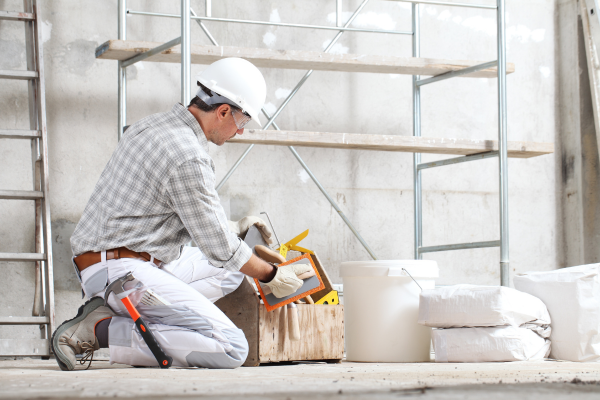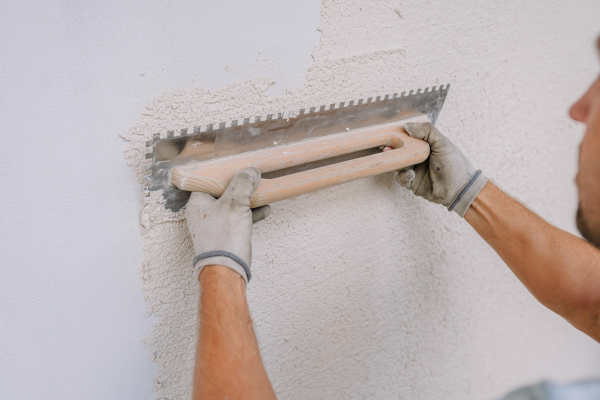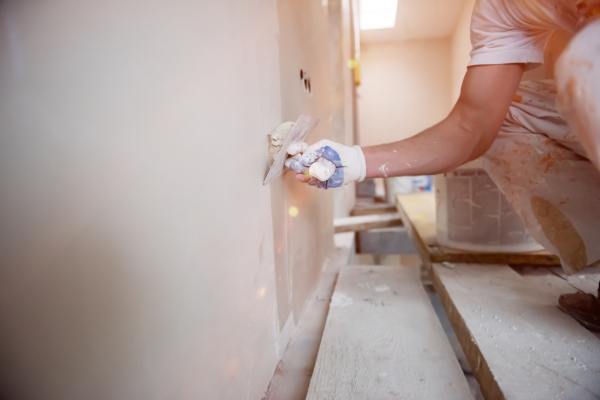Should I Take the NVQ Level 2 Plastering?
If you’re working in plastering, whether you’re self-employed, a site worker, or aiming to formalise years of experience, gaining the right qualifications can make a huge difference. The NVQ Level 2 in Plastering is a popular and respected route that will help you achieve professional and formal recognition. But how does the qualification work, and is it worth it for your career? In today’s blog, we’ll be breaking down everything you need to know about the NVQ Level 2 Plastering qualification.

What is the NVQ Level 2 Plastering?
The NVQ Level 2 in Plastering is a work-based qualification designed to assess your skills and your competency while you’re on the job. Instead of requiring classroom learning and exams, it focuses on your actual practical ability in your current job, and evidence collected from real work tasks.
The qualification covers essential plastering skills such as:
- Applying solid plastering to surfaces
- Finishing surfaces using different techniques
- Applying protective and decorative finishes
- Following health and safety regulations
- Reading and interpreting work plans and technical drawings
Completing this NVQ can make you eligible to apply for a CSCS Blue Skilled Worker Card, which is essential for working on most construction sites across the UK.
Who Should Take the NVQ Level 2 Plastering?
The NVQ Level 2 in Plastering is designed for those who:
- Are already working in plastering or rendering roles
- Need to gain a recognised qualification to prove their skills
- Want to improve their employability and site access
- Seek a pathway to further qualifications or specialisation
- Are apprentices, site labourers, or self-taught plasterers wanting official recognition
If you have practical plastering skills but you’re yet to acquire a formal qualification in your trade, or if you need a CSCS Blue Card to continue working on sites, this National Vocational Qualification could be a significant step forward for your short term, and long term, career. It’s particularly ideal for individuals who prefer to learn by doing, rather than by sitting in a classroom.
How is the NVQ in Plastering Assessed?
The assessment process for the NVQ Level 2 in Plastering is completely flexible, and based entirely on the real work you’re already used to completing on-site. You won’t need to sit any written exams. Instead, your competence will be demonstrated via:
- Direct Observation: An assessor will remotely observe you carrying out various plastering tasks
- Portfolio of Evidence: You’ll compile an online portfolio of photos, video footage, method statements, risk assessments, and work documentation to prove your competency in plastering
- Professional Discussions: These structured conversations with your assessor allow you to explain your work processes, decisions, and understanding of standards
- Witness Testimonies: Your supervisor or employer may provide statements verifying your skills and performance
Assessments are planned around your work schedule, and they are designed to cause minimal disruption to your daily tasks. The time to complete can vary depending on how quickly you gather evidence and arrange observations. For some, it’s a matter of months; for others, it can take longer. With CST Training, though, many candidates manage to obtain their qualification in just 4 to 8 weeks.
Common Misconceptions About the NVQ Level 2 Plastering
There are a few areas regarding the NVQ Level 2 in Plastering qualification that have the potential to confuse candidates, so below, we’ll clear these areas up:
- You Need to Study Full-Time: This isn’t true. NVQs are workplace qualifications; you study and get assessed while continuing your regular job
- You Must Be a Long-Time Expert: Not necessarily. If you can consistently demonstrate the required skills to the industry standard, even with a few years’ experience, you can pass
- Assessments Are Like Exams: The NVQ doesn’t involve stressful exams. It’s based on practical performance, supported by discussion and an online portfolio. The portfolio can be completed in as much time as required
- It’s Only for Young Apprentices: NVQs are available to anyone, regardless of age. Plenty of experienced workers pursue them to boost their career prospects
Understanding the reality behind these misconceptions can make pursuing your NVQ feel much more accessible, and more achievable when it comes to actually completing the NVQ process.
Who Can Take the NVQ Level 2 Plastering?
You’re eligible to take the Level 2 NVQ in Plastering if:
- You are currently employed or self-employed as a plasterer
- You have access to real work environments where evidence can be gathered
- You can perform the full range of skills required by the qualification, and can do so with confidence
- You are motivated to complete an evidence portfolio with support from your assessor
Formal academic qualifications aren’t necessary to start the NVQ. What matters most is your ability to deliver skilled plastering work to a recognised standard. If you’re unsure whether your current role covers all the areas needed, a training provider or assessor can offer guidance on whether you’re ready or need to broaden your experience first.

How to Prepare for the NVQ Level 2 Plastering
Getting prepared will make the NVQ process faster and less stressful. Here’s how you can set yourself up for success:
- Familiarise Yourself With the Standards: Know what units you need to cover throughout the NVQ
- Organise Your Work Evidence: Start taking pictures of your work, saving job sheets, and keeping copies of method statements and risk assessments
- Communicate With Your Employer: Inform your employer early on so they can help facilitate observations or provide witness testimonies
- Document Your Tasks: Keep a small diary or notes of jobs you complete that could be used as evidence
- Review Health and Safety Practices: Make sure you’re following the latest safety procedures, as this will be evaluated as part of the NVQ
- Stay Flexible and Open: Be ready to explain why you use particular materials or methods during professional discussions with your assessor
Preparing systematically helps you stay in control of the process- you’ll always know what evidence you have and what you still need to collect.
6 Tips for Gathering Evidence for the NVQ Level 2 Plastering
When it comes to the NVQ, the quality of your evidence is crucial. Here are six tips to maximise your success:
- Capture Before-and-After Photos: Show the condition of surfaces before plastering and the finished work afterward for a clear demonstration of your skill
- Demonstrate a Variety of Tasks: Don’t just show one type of plastering; include internal walls, external rendering, patch repairs, and finishes
- Collect Health and Safety Documents: Include risk assessments, and site induction paperwork where you’ve been involved
- Ask for Witness Statements: Supervisors, clients, or other tradespeople can write statements confirming the quality and professionalism of your work
- Use Video Evidence: Videos can be powerful, especially for showing techniques in action like mixing materials or applying coatings
- Label Everything Clearly: Every photo, document, or form you submit should clearly explain what it shows and which NVQ criteria it covers
A well-organised, detailed evidence portfolio will make it easier for your assessor to verify your competence quickly and efficiently.
What Comes Next After Your NVQ?
Once you achieve the NVQ Level 2 in Plastering, you’ll be well-positioned for several opportunities:
- Apply for the CSCS Blue Skilled Worker Card: This card is a requirement on many construction sites and proves your professionalism
- Increase Your Earning Potential: Qualified plasterers often earn more than unqualified workers, both on an hourly and contract basis
- Move Into Specialised Areas: You may choose to specialise in heritage plastering, decorative fibrous plastering, or external wall insulation systems
- Advance to Higher Qualifications: After Level 2, you could pursue an NVQ Level 3 in Occupational Work Supervision or the Plastering Level 3 NVQ
- Gain More Site Responsibility: With a recognised qualification, you may become eligible for team leadership or supervisory roles
Completing your NVQ not only secures your current role but also opens pathways for long-term growth and career stability.
Conclusion (Should I Take the NVQ Level 2 Plastering?)
In conclusion, the NVQ Level 2 in Plastering is a flexible, work-based qualification that offers a direct route to formal recognition of your plastering skills. It’s ideal for experienced workers who want to boost their career prospects, gain a CSCS Blue Card, and access more secure, better-paid opportunities in the construction industry.
The qualification assesses your real-world skills rather than your ability to pass exams, making it a particularly accessible option for busy tradespeople. It’s based on observations, discussions, and a portfolio of practical evidence you gather while doing your normal job.
If you’re committed to working in plastering and serious about progressing your career, taking the NVQ Level 2 is likely to be a smart and strategic investment. It not only validates the skills you already have, but can also give you a considerable edge in a competitive market, where formal qualifications and proof of competence are increasingly important.
By completing your NVQ, you’re building a foundation for long-term success — whether that’s staying on the tools, moving into specialist work, or taking on supervisory responsibilities in the future. If you’re asking yourself “Should I take the NVQ Level 2 Plastering?” — the answer is simple: if you want recognition, advancement, and better opportunities, the time to start is now.

If you still have any questions regarding the NVQ, then do not hesitate to get in touch.
Phone – 020 3488 4472





